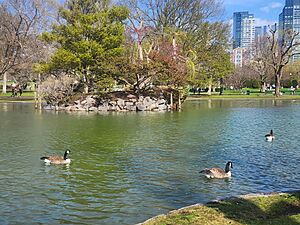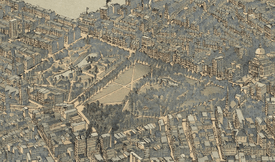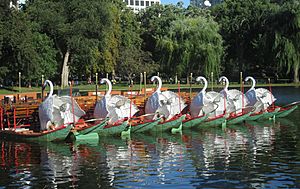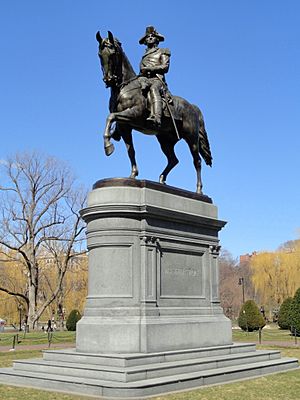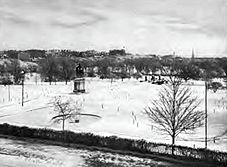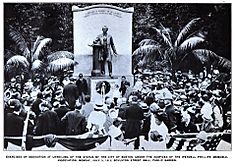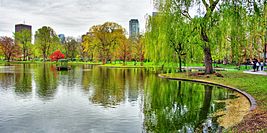Boston Public Garden facts for kids
Quick facts for kids Boston Public Garden |
|
|---|---|
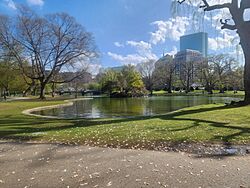
Boston Public Garden Pond in 2025
|
|
| Location | Boston, Massachusetts |
| Area | 24 acres (97,000 m2) |
|
Boston Public Garden
|
|
| NRHP reference No. | 72000144 (original) 87000761 (new) |
| Significant dates | |
| Added to NRHP | July 12, 1972 (original, in NRHP also including Boston Common) February 27, 1987 (new, as NHL of Boston Public Garden alone) |
| Designated NHLD | February 27, 1987 |
The Public Garden, also known as Boston Public Garden, is a big park right in the middle of Boston, Massachusetts. It's next to another famous park called Boston Common. This garden is special because it was the very first public botanical garden in America. A botanical garden is a place where many different kinds of plants are grown and studied.
The Public Garden is part of a larger group of parks called the Emerald Necklace. It's surrounded by Charles Street and Boston Common to the east, Beacon Street to the north, Arlington Street to the west, and Boylston Street to the south.
Contents
History of the Public Garden
How the Garden Land Was Made
Long ago, the area where the Public Garden now sits was mostly mudflats. This means it was a flat, muddy area covered by water at high tide. People started filling in this land in the early 1800s.
The land for the Public Garden was filled in first. Since 1796, a "ropewalk" was located here. A ropewalk was a long, narrow area where workers made ropes. The city gave this land to ropemakers after a fire destroyed their old workshops. In return, the ropemakers had to build a wall and fill in the muddy land.
Much of the dirt used to fill the land came from a hill called Mount Vernon in the Beacon Hill area. At first, people moved the dirt by handcarts. Later, a special gravity railroad was built to move dirt faster. Today, Mount Vernon Hill is completely gone, as all its soil was used to create new land in Boston.
Creating a Public Garden
In 1824, the city bought the land back from the ropemakers. There was an idea to turn it into a graveyard, but people voted against it.
The Public Garden officially started in 1837. A kind person named Horace Gray asked if the land could be used for America's first public botanical garden. By 1839, a group called "Horace Gray and Associates" was formed to create this garden. Even with these plans, some people wanted to sell the land for houses.
Mr. John Fottler Sr., who was called "the Father of Our Parks," brought the first plants to the garden when it opened.
Building the Garden's Features
By the mid-1800s, most of the garden's land was filled. However, there was a disagreement between the City of Boston and the state of Massachusetts about who controlled the surrounding undeveloped areas. This was settled in 1856 with an agreement called the Tripartite Indenture of 1856. Boston agreed not to build on the Public Garden, and in return, it received more land for the garden.
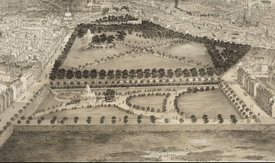
In 1859, a detailed plan for the garden was approved. Work began quickly. The pond was finished that year, and a strong wrought iron fence was put up around the park in 1862. The pond originally had a peninsula, which is land sticking out into the water. But it became a popular spot for couples, so the city forester, John Galvin, decided to cut it off, making it an island.
The garden's design was created by George F. Meacham. The paths and flower beds were planned by James Slade and John Galvin. Many fountains and statues were added in the late 1860s. One of the most famous is the large George Washington statue, finished in 1869 by Thomas Ball. It stands at the western entrance. The special suspension bridge over the pond was built in 1867.
At first, gas lamps lit the garden at night. But in 1883, electric lamps were installed. Some people worried that the wires would spoil the garden's beauty. However, electric lights were needed to replace gas lights and help prevent vandalism, like stealing flowers.
The Garden in Recent Times
In the early 1900s, baby alligators were kept in a pool near the Commonwealth Avenue entrance. Local people would feed them small animals.
Today, a flagpole stands on the eastern side of the garden. The original flagpole was destroyed by lightning in 1918. A new one was built in 1920, and a circular granite bench was added around it in 1982.
In 1913, the city decided that walking on the grass in the Public Garden and Boston Common was against the rules. People were even arrested for it until the 1960s! Now, you can sit on the grass in most areas, unless a sign says otherwise.
In 2008, a modern sprinkler system was installed. It cost $800,000 and was designed to water the many different plants and handle the garden's unique areas.
The side of the Public Garden along Charles Street used to be a messy dumping ground. It was also a wet, smelly area because it was low-lying and used to be a salt marsh. In 1895, this problem was finally fixed. A large amount of soil from the digging of the Tremont Street Subway was used to raise and regrade this part of the garden.
The Public Garden is looked after by the Mayor's Office, the City of Boston's Parks Department, and a group called the Friends of the Public Garden. It was added to the National Register of Historic Places in 1972 and became a National Historic Landmark in 1987.
The song Twilight in Boston by Jonathan Richman mentions the Garden.
What the Public Garden Looks Like
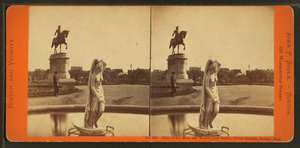
The Public Garden and Boston Common are the starting point of the Emerald Necklace, a series of parks designed by Frederick Law Olmsted. While the Common is an open space for events, the Public Garden is more like a carefully planned garden for walking and enjoying nature.
The Public Garden has a pond and many beautiful flower beds. These plantings are changed throughout the year to show different flowers each season. The garden is mostly flat and designed like an English landscape garden. It has a straight path with a bridge over the pond, connecting Charles and Arlington streets. But most of its other paths are winding and curvy.
The garden is shaped like a rectangle. It's bordered by Boylston Street to the south, Arlington Street to the west, and Beacon Street to the north. Charles Street separates it from the Common on the east.
The Pond and Swan Boats
In warmer weather, the 4 acres (16,000 m2) pond is home to many ducks and sometimes swans. A very popular activity is riding the Swan Boats, which started in 1877. For a small fee, you can ride in a boat shaped like a white swan. A guide pedals the boat around the pond from inside the swan.
Since 2020, there haven't been any real swans living in the pond. In the past, there were pairs of mute swans, including two females named Romeo and Juliet after the famous Shakespeare story.
The pond is only about three feet deep at its deepest point, so it freezes easily in winter. In 1879, the city allowed skating on the pond. But today, there's an official skating rink at Frog Pond on the Common instead.
When the pond was first built, it had some health problems because it was fed by a mix of salt water, sewer water, and fresh water. This often caused a thick slime and a bad smell. Because of this, the garden caretakers now drain and clean the pond every year.
Beautiful Plantings
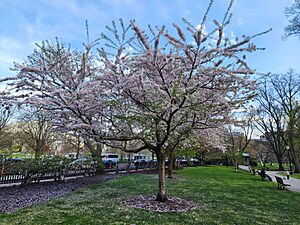
The garden has many permanent flowers, including different kinds of roses, bulbs, and flowering shrubs. The flower beds along the main path are replanted often throughout the year, showing different flowers from spring to autumn. The city grows these plants in 14 greenhouses at Franklin Park.
The Public Garden also has a wide variety of trees, both native and from other places. You'll see weeping willows around the pond and European and American elms along the paths. Other interesting trees include horse chestnuts, dawn redwoods, European beeches, ginkgo trees, and even a California redwood.
Some of the many trees you can find here are:
- Beech trees (European, Purple, Weeping)
- River birch
- Western catalpa
- Kwanzan cherry
- Kentucky coffee tree
- Bald Cypress
- Elm trees (American, English, Rock)
- Horsechestnut
- Japanese larch
- Linden trees
- Star magnolia
- Maidenhair tree
- Maple trees (Norway, Red, Silver)
- Oak trees (Burr, English, Pin)
- Redwood trees (Dawn, Giant)
- Sassafras
- Silk tree
- Tulip tree
- Weeping willow
Statues and Structures to See
The Public Garden is home to many interesting statues:
- At the Arlington Street entrance, you'll see the large statue of George Washington on horseback. It was designed by Thomas Ball and unveiled in 1869. The bronze statue is 16 feet tall and sits on a 16-foot granite base.
- Near the Washington statue is Mary E. Moore's "Small Child Fountain".
- The Ether Monument, in the northwest corner, remembers the first time ether was used to make someone unconscious during surgery. Designed by John Quincy Adams Ward, it was given to the city in 1868 and is the oldest monument in the garden. It tells the story of the Parable of the Good Samaritan.
- Close to the Ether Monument is the memorial fountain called "The Angel of the Waters." It was created in 1924 by Daniel Chester French and Henry Bacon to honor Boston helper George Robert White. It was fixed up in 2016 after being broken for many years.
- The "Triton Babies Fountain" on the east side was made by Anna Coleman Ladd, the first woman to create a statue for the Garden. The children in the statue are her two daughters.
- Bashka Paeff's "Boy and Bird" statue is on the west side. Bashka Paeff was an immigrant from Russia who modeled this while working at a train station.
- Lillian Saarinen's "Bagheera" is a statue of the panther from Kipling's Jungle Book, almost hidden by a tree.
- A set of bronze statues by Nancy Schön from 1987 shows the characters from the children's book Make Way for Ducklings. You can find them between the pond and the Charles and Beacon streets entrance.
- At the east gate on Charles Street is a bronze statue of Edward Everett Hale, presented in 1913.
- Along the south path is a statue of Wendell Phillips (1811–1884), a speaker and abolitionist who fought to end slavery. It was put up in 1915.
- Colonel Thomas Cass, who led soldiers in the American Civil War, also has a memorial on the south path, built in 1899.
- Next to Cass's statue is Thomas Ball's statue of Charles Sumner, a U.S. senator from Massachusetts who served from 1851 to 1874. This statue was built in 1878.
- The path also has a statue of Tadeusz Kościuszko, a Polish person who fought in the American Revolution. Artist Theo Alice Ruggles Kitson created it in 1927.
- A statue of William Ellery Channing stands at the southwest corner, facing the Arlington Street Church. It was finished in 1903.
- The Boston Public Garden Foot Bridge crosses the pond. Designed by William G. Preston, it opened in 1867. It was once the shortest working suspension bridge in the world before it was changed in 1921. Its suspension cables are now just for decoration.
- A Japanese garden lantern from 1587 was given to Boston in 1906. It's one of the oldest lanterns of its kind and was originally in a palace garden in Kyoto, Japan.
- In July 2004, a memorial was dedicated to the 206 people from Massachusetts who died in the September 11, 2001, terrorist attacks. It's located inside the Public Garden, near Arlington and Newbury streets.
- At the start of the bridge, near the Swan Boat steps, there's a plaque honoring U.S. Marine Lt. Michael P. Quinn, who died in Vietnam in 1969.
Taking Care of the Park
The City of Boston helps maintain the park. A group called the Friends of the Public Garden, also known as the Rose Brigade, also helps a lot. This group helped pay to fix the Ether Monument in 2006. They also hire experts to care for the trees and bushes. Volunteers regularly meet to trim and look after the plants. Other groups, like the Beacon Hill Garden Club, also provide money to help.
Gallery
-
Memorial to Wendell Phillips, 2007
-
The Ether Monument by John Quincy Adams Ward, 2008
See also


